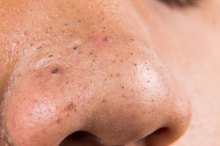How to Clean Nose Pores
Your skin naturally excretes oil every day. This helps keep your face hydrated, but it can also clog pores and make your face look dirty. While it seems like these pores are just random holes on your face, they're actually the openings of hair follicles, and they're more noticeable on your face because the sebaceous glands that produce the oil are bigger.
Genetics are the main influencer of pore size, but those who have darker or oil skin will find that their pores are more noticeable. Environmental factors also play a role in pore size, so you can take measures to reduce the size of your pores through healthy habits 1.
Read more: What Causes Big Pores on the Face?
Cleanse Your Pores
Pores that are clogged will look bigger than those that are clean, so wash your face with a gentle cleanser and warm water daily. Ideally, you should clean your face before you go to bed, when you wake up in the morning and after exercising or performing any other activity that makes you sweat.
Clean your nose and other problem areas with a facial scrub two to three times per week. Facial scrubs exfoliate skin and remove oils that can cause acne breakouts. Use a creamy exfoliating product if you have dry skin. If you have oily or acne-prone skin, use a scrub that contains salicylic acid.
If you prefer something all natural, dampen your face with water, then rub a pinch of baking soda into your skin. Rinse with cool water after one minute. Baking soda kills bacteria and sloughs away dead skin cells.
As an extra step, apply a clay mask to your forehead, chin and nose twice per week. Allow the clay mask to dry and then peel it off. The clay gently extracts oils and dirt from your pores.
Read more: How to Clear Clogged Pores in Adults
- Pores that are clogged will look bigger than those that are clean, so wash your face with a gentle cleanser and warm water daily.
- If you prefer something all natural, dampen your face with water, then rub a pinch of baking soda into your skin.
Head to the Spa
How to Get Rid of Deep Clogged Pores
Learn More
Give yourself a little something nice, and treat yourself to a facial every six to eight weeks. During a facial, an aesthetician safely extracts oil and other debris from your pores using special cleansing instruments.
If you can't get a facial, achieve similar results by very gently squeezing skin in 1/2-inch sections. If the oil in your pores is soft enough, squeezing will help extract it. If the oil won't come out, do not squeeze your skin any harder — doing so may cause injury.
- Give yourself a little something nice, and treat yourself to a facial every six to eight weeks.
- If the oil won't come out, do not squeeze your skin any harder — doing so may cause injury.
Visit a Pore Pro
Sometimes, the pores need professional help. Get a salicylic or glycolic acid peel from your dermatologist if your pores don't respond to self-treatment. It usually takes about three treatments to tighten pores and see results. Dermatologists may also prescribe you a stronger exfoliant you can purchase from a pharmacy.
- Sometimes, the pores need professional help.
- Dermatologists may also prescribe you a stronger exfoliant you can purchase from a pharmacy.
Related Articles
References
- Leslie Baumann, MD: How to Reduce the Size of Your Pores
- Wang S. Understudied skin characteristics awaiting genetic breakthroughs. J Investig Dermatol Symp Proc. 2018;19(2):S101-S102. doi:10.1016/j.jisp.2018.10.005
- American Academy of Dermatology Association. What can treat large pores?
- Draelos ZD. Cosmeceuticals for male skin. Dermatologic Clinics. 2018;36(1):17-20
- Milam EC, Rieder EA. An approach to cosmeceuticals. Journal of Drugs in Dermatology. 2016;15(4):452-6.
- Sakuma TH, Maibach HI. Oily skin: an overview. Skin Pharmacology and Physiology. 2012;25(5):227-35.
- Yeh L, Bonati LM, Silverberg NB. Topical retinoids for acne. Seminars in Cutaneous Medicine and Surgery. 2016;35(2):50-6.
- Zaenglein AL, Pathy AL, Schlosser BJ, et al. Guidelines of care for the management of acne vulgaris. Journal of the American Academy of Dermatology. 2016;74(5):945-73.
Writer Bio
Melissa King began writing in 2001. She spent three years writing for her local newspaper, "The Colt," writing editorials, news stories, product reviews and entertainment pieces. She is also the owner and operator of Howbert Freelance Writing. King holds an Associate of Arts in communications from Tarrant County College.









